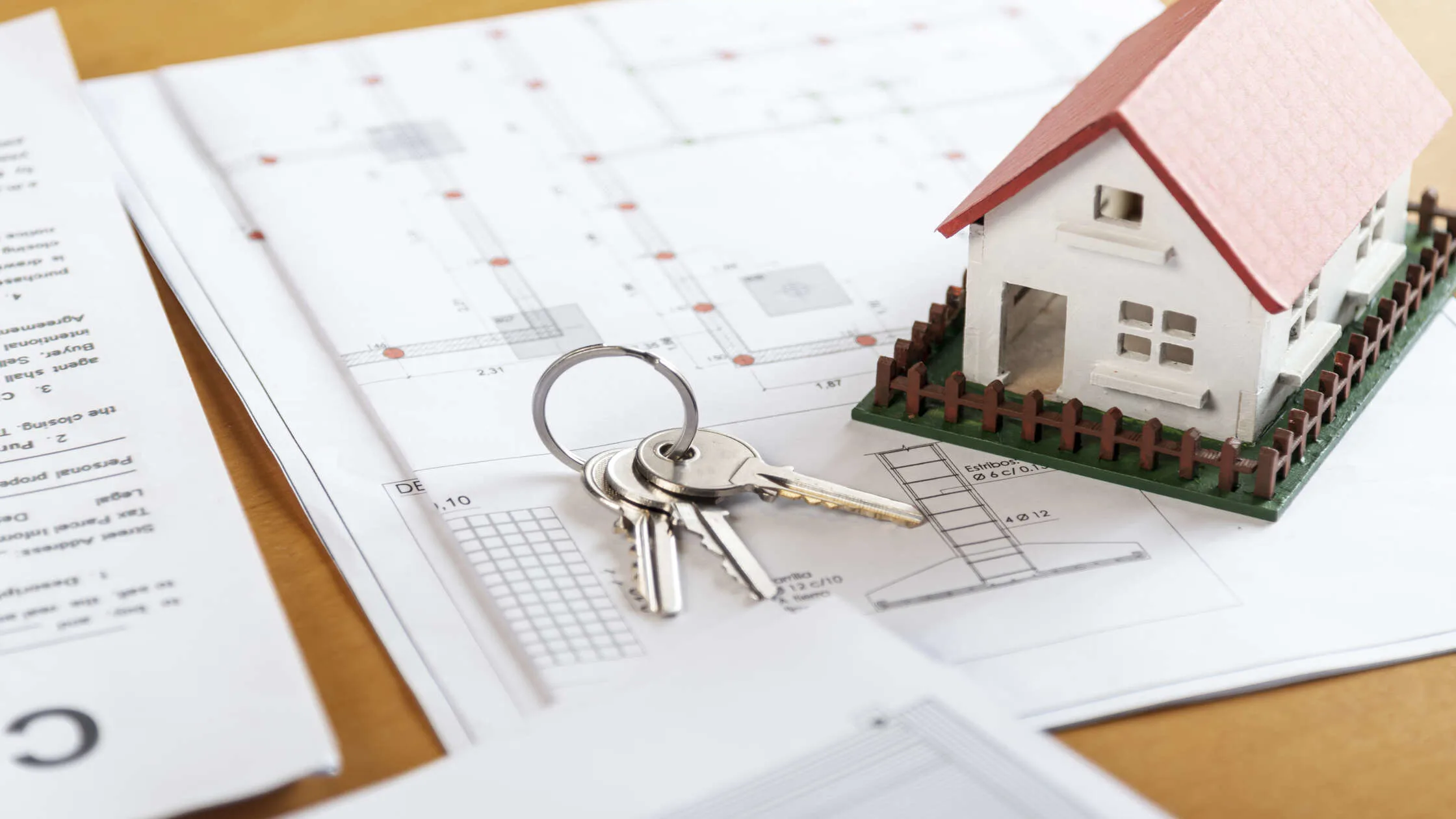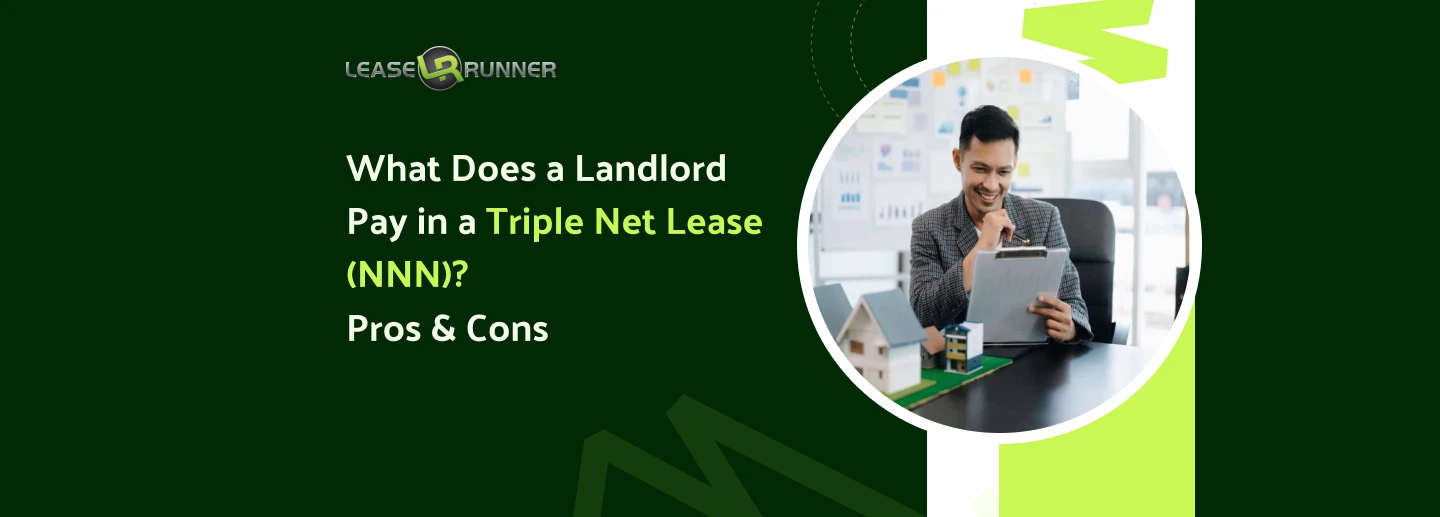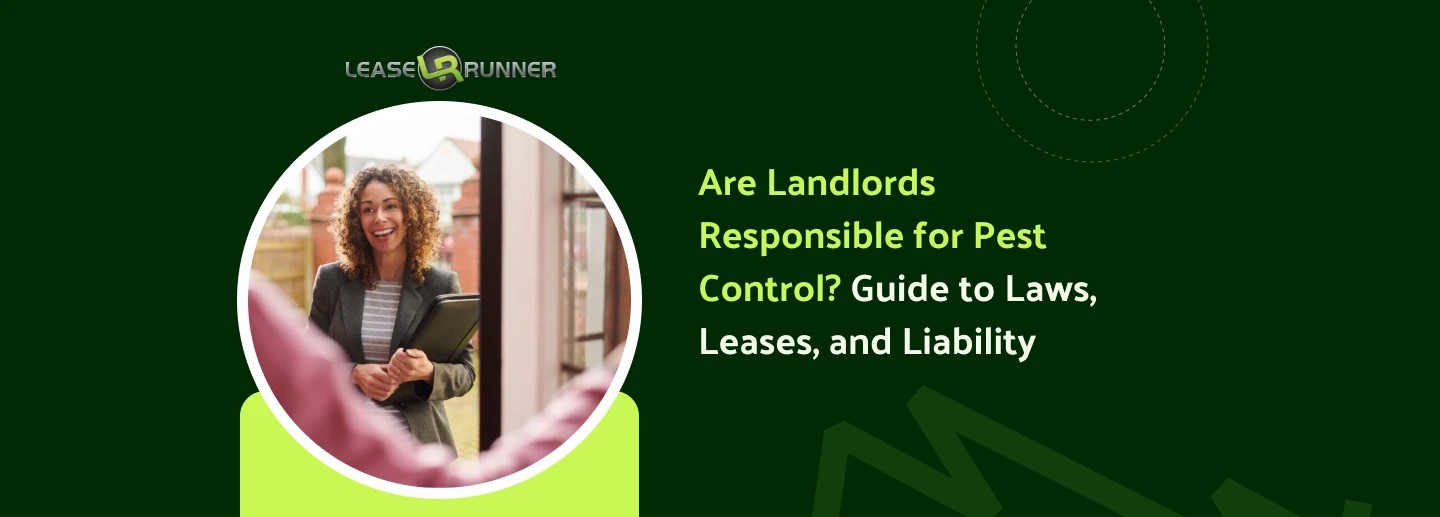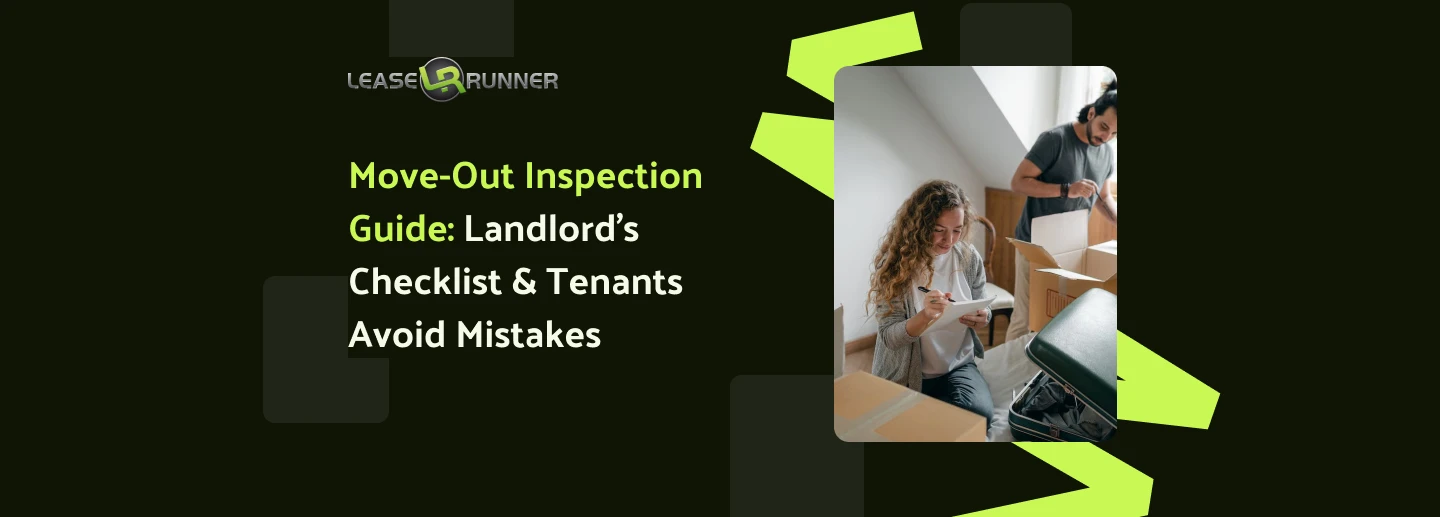What does landlord pay in triple net lease agreements? Triple net leases (NNN) are often touted as a dream for passive-income investors, but what are the actual landlord responsibilities in an NNN lease? While tenants cover taxes, insurance, and maintenance, landlords aren’t completely off the hook. In this article, we’ll break down exactly what financial obligations landlords still hold under NNN leases.

What is a Triple Net Lease (NNN)?
So, what are triple net expenses?
A Triple Net Lease is a commercial real estate agreement where the tenant is responsible for nearly all of the property's operating expenses in addition to their base rent. These costs are often referred to as the "three nets":
- Property Taxes
- Building Insurance
- Maintenance & Repairs
Unlike a gross lease, where landlords absorb most (or all) operational costs and utilities, the NNN model turns the tenant into a sort of co-operator of the building, one who maintains its value and handles its everyday financial obligations. In some cases, tenants may even sublease the property to another operator, passing along the variable NNN responsibilities.
This model is especially common for single-tenant buildings like retail stores, fast-food restaurants, and industrial properties. Investors often favor NNN properties with long-term leases (10-20 years) and creditworthy tenants (e.g., major national chains) because they require minimal day-to-day management. However, it’s a misconception that landlords pay nothing at all.

What Does a Landlord Pay in a Triple Net Lease?
Triple net leases are often marketed as a “hands-off” investment because tenants cover most day-to-day operating expenses such as property taxes, insurance, and common area maintenance (CAM).
However, this does not mean the landlord is free of costs. In fact, landlords still hold significant financial and legal responsibilities that can impact profitability and long-term asset value.
Landlord responsibilities:
Triple net leases are often marketed as “hands-off” investments because tenants cover property taxes, insurance, and common area maintenance (CAM) charges. But landlords are not exempt from all costs.
Landlord pays vs tenant pays in NNN leases depends heavily on negotiation. Here are the most common landlord responsibilities:
- Major Structural Repairs: Landlords remain liable for roof replacement responsibility, foundation repair landlord obligations, and exterior wall issues landlord duty. These repairs can easily run into tens of thousands of dollars.
- Capital Expenditures: Big-ticket property upgrades, such as a new HVAC system landlord cost, are often considered landlord obligations, even if day-to-day HVAC tune-ups are tenant duties.
- Vacancy Costs: If a property sits empty, vacancy costs become the landlord’s obligation, including taxes, insurance, and utilities until a new tenant is secured.
- Mortgage Payments and Financing Costs: Regardless of lease terms, the landlord must handle all mortgage payments in an NNN lease and any associated financing costs for the property.
- Insurance Gaps and Deductibles: Even if tenants cover building insurance, certain exclusions or deductibles fall back to the landlord.
- Common Area Maintenance (CAM) Landlord Duties: While tenants pay most CAM costs, landlords may cover portions such as parking lot maintenance landlord responsibility or capital improvements in shared spaces.
- Legal, Administrative, and Negotiation Fees: Lease negotiation in a triple net lease requires legal review and sometimes ongoing compliance costs.
If you’re considering raising rent after upgrades, read how much can the landlord raise rent for important limits and regulations. Landlords must also ensure repairs are done promptly, as required by law, which can be checked against how long does a landlord have to fix something. Additionally, distinguishing between repair costs and normal wear and tear is crucial to prevent overpaying or disputing charges.

Triple Net Lease Calculator: How to Accurately Calculate NNN Charges
If you’re asking, how does NNN work in practice? it comes down to accurate cost allocation. A triple net lease calculator helps landlords and tenants determine rent plus NNN expenses.
Inputs You’ll Need for the NNN Calculation
Before using a triple net lease calculator, you should gather the following key figures. Each one plays a role in determining your actual occupancy cost:
- Total Square Footage: The total rentable space in the building. This number is crucial when calculating a tenant’s share in a multi-tenant property.
- Base Rent per Square Foot (Annual): The agreed-upon rent rate charged for each square foot of leased space, calculated annually. This figure does not include operating expenses.
- Property Taxes per Square Foot (Annual): The cost of local property taxes, divided by the property’s total square footage. Tenants pay their portion based on their leased area.
- Property Insurance per Square Foot (Annual): The annual insurance premium on the building, spread across the total square footage. This typically covers structural insurance, not the tenant’s business insurance.
- Common Area Maintenance (CAM) per Square Foot (Annual): The cost of maintaining shared spaces such as lobbies, hallways, landscaping, lighting, and parking lots. CAM charges may also include management or administrative fees.
- Your Share of Expenses: In a multi-tenant building, this is the percentage of total NNN expenses the tenant is responsible for, based on the size of their leased space relative to the entire building.
Triple Net Lease Calculator
Follow these steps to accurately determine a tenant's total monthly rent, which includes both the base rent and the NNN charge
1. Identify the expenses included in your NNN lease
Not every lease includes the same items in CAM charges. Review your lease carefully to confirm whether expenses such as administrative fees, security, or repairs are included.
2. Gather key figures for the calculation
Collect the numbers outlined above (base rent, taxes, insurance, CAM, and your share). Make sure they are expressed on a per-square-foot annual basis to keep calculations consisten.
3. Calculate your monthly NNN charges
The way you calculate the total rent depends on whether the lease is for a single-tenant or a multi-tenant building.
For a Single-Tenant Building: In a single-tenant NNN lease, the tenant is typically responsible for 100% of all NNN expenses.
- Calculate Annual NNN Charges: Multiply the NNN cost per square foot by the total square footage.
- Calculate Total Monthly Rent: Add the annual base rent and the annual NNN charges, then divide by 12.
For a Multi-Tenant Building: In a multi-tenant lease, each tenant pays a proportional share of the NNN expenses based on their leased square footage.
- Calculate Tenant's Proportional Share: Divide the tenant's total square footage by the building's total rentable square footage.
- Calculate Tenant's Annual NNN Charges: Multiply the building's total annual NNN expenses by the tenant's proportional share.
- Calculate Total Monthly Rent: Add the tenant's annual base rent and their annual NNN charges, then divide by 12.
4. Perform an annual NNN reconciliation
An essential part of managing an NNN lease is performing an annual reconciliation. This process involves comparing the estimated NNN payments you collected from the tenant throughout the year with the actual, final expenses for that same period.
- If the tenant overpaid, you must issue a credit or refund for the difference.
- If the tenant underpaid, you can bill them for the remaining amount.
This process ensures accuracy and transparency, helping to maintain a strong relationship with your tenant.
Example Triple Net Lease Calculator
Let's walk through a practical example for a single-tenant building. This process ensures accuracy and transparency, helping to maintain a strong relationship with your tenant. Landlords who understand what does landlord pay in triple net lease can avoid disputes during reconciliation.
Inputs:
- Total Square Footage: 2,500 sq. ft.
- Base Rent per Sq. Ft. (Annual): $20
- Property Taxes per Sq. Ft. (Annual): $4
- Property Insurance per Sq. Ft. (Annual): $1.5
- CAM per Sq. Ft. (Annual): $2.5
Step 1: Calculate Total NNN Cost per Square Foot
NNN Cost per Sq. Ft. = $4 + $1.5 + $2.5 = $8
Step 2: Calculate Total Annual Rent
Annual Base Rent: $2,500 x 20$ = $50,000
Annual NNN Charges: $2,500 x $8 = $20,000
Total Annual Rent: $50,000 + $20,000 = $70,000
Step 3: Calculate Total Monthly Rent
Total Monthly Rent = $70,000 / 12 months = $5,833.33
In this example, the tenant's total monthly payment would be $5,833.33.
Pros and Cons of Triple Net Leases for Landlords
Triple Net Leases can be a landlord’s “best friend” or a hidden challenge, depending on the property, tenant, and lease structure.
Benefits for Landlords
At first glance, triple net leases (NNN) seem like every landlord’s dream—and in many ways, they are. From reduced day-to-day responsibilities to long-term financial stability, these lease structures offer several compelling advantages for property owners.
- Predictable, Passive Income: With tenants covering taxes, insurance, and maintenance, landlords enjoy more stable cash flow. Once the lease is in place, rent checks typically arrive with minimal oversight.
- Reduced Operational Responsibilities: Property management becomes simpler. Instead of coordinating landscaping, utility bills, or snow removal, landlords can step back while tenants handle most of the day-to-day upkeep.
- Control Over Asset Value Through Preventive Maintenance: Many landlords require tenants to enter into regular service contracts for key systems like HVAC, roofing, or elevators. These agreements ensure consistent upkeep, protecting the long-term value of the property and preventing costly deferred maintenance issues.
- Return Conditions in Leases: Landlords can include provisions that obligate tenants to return the property in good condition at the end of the lease. This prevents tenants from cutting corners on maintenance and ensures the asset is preserved for future use or resale.
- Attractive to Investors: Because of the lower risk and reduced involvement, properties under NNN leases are in high demand, often commanding premium valuations when sold.
- Inflation Hedge: Many NNN leases include built-in rent escalations, allowing landlords to maintain or increase income streams in line with inflation, particularly over long-term lease agreements of 10–20 years.
Drawbacks for Landlords
Of course, no investment is without risk. Despite the passive appeal of NNN leases, landlords should be aware of certain downsides.
- Lower Rent Rates: Since tenants take on more financial responsibility, base rent in NNN leases is typically lower than in gross or modified gross leases.
- Responsibility for Structural Repairs: In most NNN leases, capital expenditures like roof replacements, foundation repairs, and structural elements still fall on the landlord.
- Risk of Tenant Under-Maintaining: While tenants are tasked with ongoing maintenance, some may intentionally cut back on upkeep to lower their overall “effective rent.” This deferred maintenance - whether on HVAC, roofing, or parking lots—can gradually reduce the property’s long-term value, leaving landlords with higher repair costs later.
- Market Incentive Limitations: In theory, landlords have an incentive to keep operating costs reasonable to maintain competitiveness. However, because most expenses are passed through to tenants, tenants often worry that landlords lack motivation to control costs. This can create friction during lease negotiations or renewals.
- Multi-Tenant vs. Single-Tenant Dynamics: The risk profile shifts depending on the type of property. In multi-tenant properties, landlords often need to directly manage common areas and then pass costs through to tenants, which requires more oversight and transparency. In single-tenant properties, tenants usually handle maintenance themselves, but the danger of under-maintenance is even higher since one party controls the entire property.
- Re-Tenanting Complexity: Finding new tenants for NNN properties—especially single-tenant locations—can be challenging. The highly specific nature of the lease and property use may limit the tenant pool.
Triple Net Lease vs Gross Lease: Key Differences
Not all commercial leases (can be fixed-term or month-to-month lease are created equal. The difference between a Triple Net Lease (NNN) and a Gross Lease can dramatically shift who pays for what and how risky or hands-off the investment is.
In a gross lease, the tenant pays a single, all-inclusive rent. This amount covers everything: property taxes, building insurance, maintenance, utilities, and often janitorial services. For tenants, this setup offers predictable monthly costs, which is ideal for budgeting.
But for landlords? It’s a mixed bag. While it provides control, it also exposes the owner to all variable costs. If taxes go up or the roof leaks, those bills eat directly into profits. This is the opposite of what a landlord pays in triple net lease, where many costs are shifted to tenants.
In contrast, Triple Net leases shift those variable costs to the tenant. In an NNN agreement, the tenant pays property taxes, insurance, and most maintenance, while the landlord still handles capital expenditures and structural repairs. In return, they often enjoy lower base rent and more control over the space.
For landlords, NNN leases reduce operational involvement and make income more predictable, especially if the lease includes annual rent escalations or a long-term tenant with good credit.
Key differences:
- In a gross lease, landlords manage the property and its costs.
- In a triple net lease, tenants take on most of the financial responsibility.
- For investors, the choice often comes down to risk tolerance, property type, and long-term strategy
Understanding landlord pays vs tenant pays NNN helps investors weigh operational risk and income stability.
Typical costs covered by tenants
In a Triple Net Lease (NNN), tenants become the financial stewards of the property. In addition to their base rent, they are typically responsible for the following costs:
- Property Taxes: Tenants are responsible for paying their share, or all, of the annual property taxes on the building. In single-tenant properties, this typically means 100% of the bill. For multi-tenant spaces, costs are divided by square footage or another fair metric.
- Insurance: Tenants pay the premiums for insurance that covers the building structure, not just their contents or liability. This ensures that if a fire or other insurable event occurs, the structure itself is protected.
- Maintenance and Repairs: From landscaping and snow removal to plumbing issues and HVAC tune-ups, the tenant is in charge of keeping the property functional and clean. This includes both interior maintenance and sometimes shared spaces under CAM (Common Area Maintenance).
- Utilities: Electricity, water, trash service, and any other necessary utilities are also tenant responsibilities.
- CAM (Common Area Maintenance) Fees: In shopping centers or office parks, tenants may also pay into a CAM pool that covers parking lots, hallways, security, and exterior lighting. These costs are usually itemized and billed monthly or quarterly.
Landlords must carefully screen tenants to avoid issues with payment or property maintenance. Conducting a thorough tenant background screening and verifying financial documents, including spotting fake pay stubs, ensures tenant reliability. It’s also important to clarify who handles the broker fee to prevent disputes.
Tax Implications for Landlords in NNN Leases
Even though tenant pays property taxes, landlords still face several tax considerations that directly impact their bottom line.
- Income Tax on Rental Revenue: Rental income earned from an NNN lease is still considered taxable income by the IRS. While landlords can deduct operating expenses (if any), depreciation, and interest, they should still expect to pay federal and possibly state income taxes.
- Capital Gains Tax: If a landlord sells a property that’s appreciated in value, they may owe capital gains tax on the profit. The rate depends on how long they’ve held the asset and their personal income level. Landlords must carefully evaluate triple net lease tax consequences, from income tax on rental revenue to capital gains exposure.
Tip: Using a 1031 exchange allows landlords to defer this tax while preserving clarity on what does landlord pay in triple net lease.
- Local and State Tax Obligations: Some states impose additional taxes on rental income or property sales, especially for commercial real estate. Landlords should also consider franchise taxes, business license taxes, and even gross receipts taxes, depending on their legal entity type.
Tax planning is key to keeping more of your passive income. Some practical strategies below can help you do this task more efficiently:
- Hire a Real Estate CPA: A professional will help you claim every legal deduction and structure your finances for maximum efficiency.
- Use Depreciation Wisely: Buildings can be depreciated over 39 years. This non-cash expense can significantly reduce taxable income.
- Consider Legal Entity Structures: Holding the property in an LLC or partnership may offer tax advantages and liability protection.
- Track Capital Improvements: Document all upgrades and improvements to increase your cost basis and reduce capital gains when you sell.
- Explore a 1031 Exchange: Defer taxes and grow your portfolio tax-efficiently by rolling proceeds from a sale into another investment property.
Final Thoughts
Many investors are drawn to triple net leases for their simplicity, but knowing what does landlord pay in triple net lease is key to long-term success. When structured well, these leases can produce steady income with minimal oversight.
Want more insights on lease strategies, landlord responsibilities, and investment tips? Explore the LeaseRunner Blog!
FAQs
Q1. What does NNN include?
NNN, or Triple Net, includes three key expenses that tenants are responsible for, on top of their base rent:
- Property Taxes: The full amount assessed by local governments.
- Building Insurance: Coverage for the structure itself, not just the tenant’s contents.
- Maintenance Costs: Everything from routine upkeep (like landscaping and janitorial services) to minor repairs and common area expenses (CAM).
Q2. How much is triple net usually?
The cost of a triple net lease typically includes two components: the base rent and the NNN expenses. While the base rent is negotiated between landlord and tenant, the NNN charges themselves can range widely. On average, triple net expenses fall between $4 to $12 per square foot per year.
Q3. How does a triple net lease (NNN) work?
A triple net lease shifts most of the financial responsibility for operating a commercial property to the tenant. Here’s how it works:
- The tenant pays base rent + NNN expenses (property taxes, insurance, and maintenance).
- The landlord receives predictable income with fewer operational responsibilities.
- Lease agreements often include annual rent escalations, long terms (5–20 years), and clauses for maintenance standards or capital expense exclusions.
This model is popular with retail chains, single-tenant properties, and investors seeking passive income. However, it only works well if the lease is clearly written and the tenant is financially stable. Reviewing what the landlord pays in triple net lease before signing is crucial.







